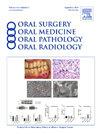The importance of having conventional 2-dimensional radiographs reviewed by oral and maxillofacial radiologists
IF 2
3区 医学
Q2 DENTISTRY, ORAL SURGERY & MEDICINE
Oral Surgery Oral Medicine Oral Pathology Oral Radiology
Pub Date : 2025-02-04
DOI:10.1016/j.oooo.2024.11.069
引用次数: 0
Abstract
The following examples reflect the importance of periodic imaging, review of radiographs, and knowing when to refer to an oral and maxillofacial radiologist for further evaluation. In the first case, a 26-year-old male dental student obtained a panoramic radiograph in September 2019, stating “I would like to get a pano since I have never had one.” The radiographic findings were reported by a general dentist as “No pathology present. Patient has no missing teeth.” Two years later, the patient, now the proud owner of a cone beam computed tomography (CBCT) machine, noticed changes in the left posterior maxillary area and had a CBCT acquired and sent the volume for a report. The area ended up being a plum-sized OKC that required extensive surgical intervention and follow-up. In the second case, A 79-year-old female patient complained of pain on chewing from a crown that was seated in November 2021, but clinical pain originated from #31. The patient developed a large fluctuant swelling in late December 2021/early January 2022 that had cervical lymph node involvement. #31 displayed bone loss on the PA and had 10 mm + pocketing, class III mobility, and heavy occlusal contact with #2. #31 was extracted on January 16, 2022 and a bovine graft was placed. Her discomfort somewhat resolved, but chewing discomfort returned 1/30/22. A PA taken February 4, 2022, revealed that bone loss has extended to #30. These periapical radiographs were never sent for review until February 2022, when a CBCT volume was acquired and sent for review. The findings were highly suggestive of an aggressive process such as gingival carcinoma invading the bone. The patient was the referring doctor's mother, and no follow-up information was provided due to the sensitive nature of the case.
求助全文
约1分钟内获得全文
求助全文
来源期刊

Oral Surgery Oral Medicine Oral Pathology Oral Radiology
DENTISTRY, ORAL SURGERY & MEDICINE-
CiteScore
3.80
自引率
6.90%
发文量
1217
审稿时长
2-4 weeks
期刊介绍:
Oral Surgery, Oral Medicine, Oral Pathology and Oral Radiology is required reading for anyone in the fields of oral surgery, oral medicine, oral pathology, oral radiology or advanced general practice dentistry. It is the only major dental journal that provides a practical and complete overview of the medical and surgical techniques of dental practice in four areas. Topics covered include such current issues as dental implants, treatment of HIV-infected patients, and evaluation and treatment of TMJ disorders. The official publication for nine societies, the Journal is recommended for initial purchase in the Brandon Hill study, Selected List of Books and Journals for the Small Medical Library.
 求助内容:
求助内容: 应助结果提醒方式:
应助结果提醒方式:


